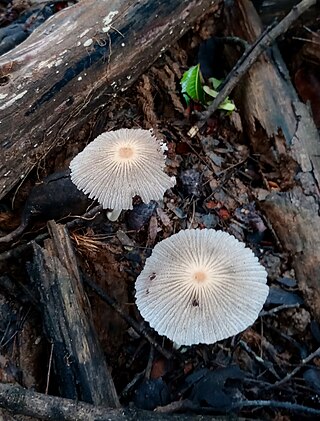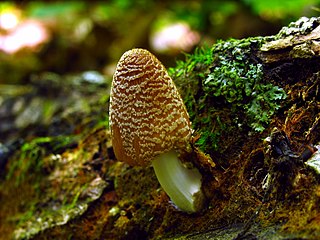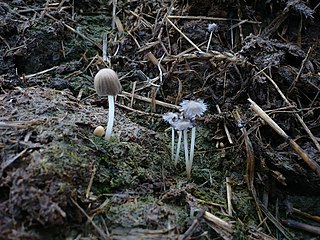
Coprinus is a small genus of mushroom-forming fungi consisting of Coprinus comatus—the shaggy ink cap (British) or shaggy mane (American)—and several of its close relatives. Until 2001, Coprinus was a large genus consisting of all agaric species in which the lamellae autodigested to release their spores. The black ink-like liquid this creates gave these species their common name "ink cap" (British) or "inky cap" (American).

The Psathyrellaceae are a family of dark-spored agarics that generally have rather soft, fragile fruiting bodies, and are characterized by black, dark brown, rarely reddish, or even pastel-colored spore prints. About 50% of species produce fruiting bodies that dissolve into ink-like ooze when the spores are mature via autodigestion. Prior to phylogenetic research based upon DNA comparisons, most of the species that autodigested were classified as Coprinaceae, which contained all of the inky-cap mushrooms. However, the type species of Coprinus, Coprinus comatus, and a few other species, were found to be more closely related to Agaricaceae. The former genus Coprinus was split between two families, and the name "Coprinaceae" became a synonym of Agaricaceae in its 21st-century phylogenetic redefinition. Note that in the 19th and early 20th centuries the family name Agaricaceae had far broader application, while in the late 20th century it had a narrower application. The family name Psathyrellaceae is based on the former Coprinaceae subfamily name Psathyrelloideae. The type genus Psathyrella consists of species that produce fruiting bodies which do not liquify via autodigestion. Psathyrella remained a polyphyletic genus until it was split into several genera including 3 new ones in 2015. Lacrymaria is another genus that does not autodigest its fruiting bodies. It is characterized by rough basidiospores and lamellar edges that exude beads of clear liquid when in prime condition, hence the Latin reference, lacryma (tears).

Coprinellus is a genus of mushroom-forming fungi in the family Psathyrellaceae. The genus was circumscribed by the Finnish mycologist Petter Adolf Karsten in 1879. Most Coprinellus species were transferred from the once large genus Coprinus. Molecular studies published in 2001 redistributed Coprinus species to Psathyrella, or the segregate genera Coprinopsis and Coprinellus.

Tulosesus amphithallus is a species of mushroom producing fungus in the family Psathyrellaceae.

Coprinellus aureogranulatus is a species of mushroom in the family Psathyrellaceae. It was first described as Coprinus aureogranulatus by mycologists C.B. Uljé and A. Aptroot in 1998, and later transferred to the genus Coprinellus in 2001.

Coprinellus domesticus, commonly known as the domestic inky cap, or firerug inkcap, is a species of mushroom in the family Psathyrellaceae. First described as Agaricus domesticus by James Bolton in 1788, it was later known as Coprinus domesticus before it was transferred to the genus Coprinellus in 2001.
Coprinellus dilectus is a species of mushroom in the family Psathyrellaceae. It was first described as Coprinus dilectus by mycologist Elias Magnus Fries in 1838, and later transferred to the genus Coprinellus in 2001.
Coprinellus curtus is a species of mushroom in the family Psathyrellaceae. It was first described as Coprinus curtus by Károly Kalchbrenner in 1876 before being transferred to the genus Coprinellus in 2001.
Tulosesus callinus is a species of mushroom producing fungus in the family Psathyrellaceae.

Tulosesus bisporus is a species of mushroom producing fungus in the family Psathyrellaceae.
Coprinellus pyrrhanthes is a species of mushroom in the family Psathyrellaceae. First described as Coprinus pyrrhanthes by the mycologist Henri Romagnesi in 1951, it was later transferred to the genus Coprinellus in 2001.
Tulosesus heterosetulosus is a species of mushroom producing fungus in the family Psathyrellaceae.

Coprinellus xanthothrix is a species of fungus in the family Psathyrellaceae. This species was isolated from a polyphenol-polluted site near an olive processing plant in Greece. Shown to have the enzymes laccase and manganese peroxidase, the fungus is able to decolorize the recalcitrant polymeric dye R-478. First described as Coprinus xanthothrix by the French mycologist Henri Romagnesi in 1941, it was later transferred to the genus Coprinellus in 2001.
Tulosesus subpurpureus is a species of mushroom producing fungus in the family Psathyrellaceae.
Tulosesus subimpatiens is a species of mushroom producing fungus in the family Psathyrellaceae.
Tulosesus subdisseminatus is a species of mushroom producing fungus in the family Psathyrellaceae.
Tulosesus sclerocystidiosus is a species of mushroom producing fungus in the family Psathyrellaceae.
Tulosesus sassii is a species of mushroom producing fungus in the family Psathyrellaceae.

Tulosesus impatiens is a species of fungus in the family Psathyrellaceae. First described in 1821, it has been classified variously in the genera Psathyrella, Pseudocoprinus, Coprinarius, and Coprinus, before molecular phylogenetics reaffirmed it as a Coprinellus species in 2001. The fungus is found in North America and Europe, where the mushrooms grow on the ground in deciduous forests. The fruit bodies have buff caps that are up to 4 cm (1.6 in) in diameter, held by slender whitish stems that can be up to 10 cm (3.9 in) tall. Several other Coprinopsis species that resemble C. impatiens may be distinguished by differences in appearance, habit, or spore morphology.

Parasola auricoma is a species of agaric fungus in the family Psathyrellaceae. First described scientifically in 1886, the species is found in Europe, Japan, and North America. The mushroom was reported in February 2019 in Colombia, in the city of Bogota by the mycologist Juan Camilo Rodriguez Martinez. The small, umbrella-shaped fruit bodies (mushrooms) of the fungus grow in grass or woodchips and are short-lived, usually collapsing with age in a few hours. The caps are up to 6 cm (2.4 in) wide, initially elliptical before flattening out, and colored reddish-brown to greyish, depending on their age and hydration. They are pleated with radial grooves extending from the center to the edge of the cap. The slender, whitish stems are up to 12 cm (4.7 in) long and a few millimeters thick. Microscopically, P. auricoma is characterized by the presence of setae in its cap cuticle. This characteristic, in addition to the relatively large, ellipsoid spores can be used to distinguish it from other morphologically similar Parasola species.









